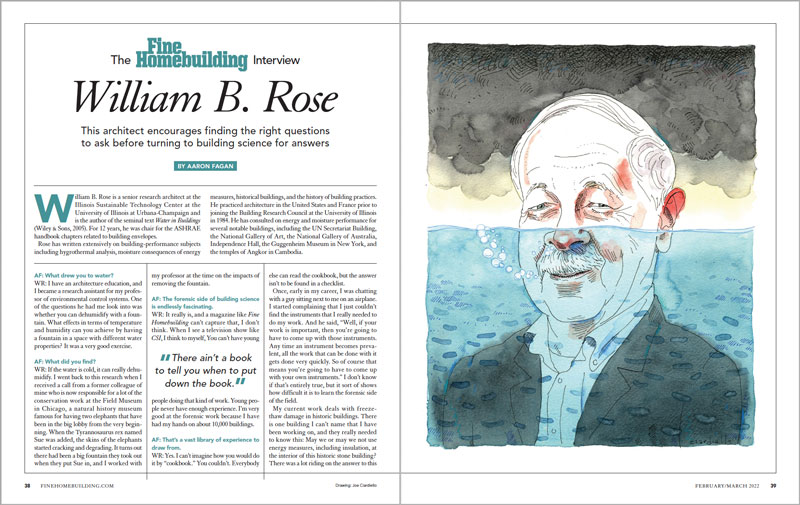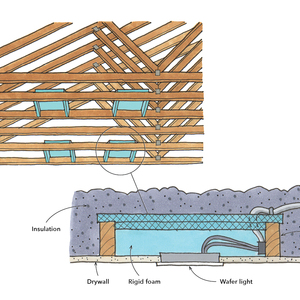The Fine Homebuilding Interview: William B. Rose
This architect encourages finding the right questions to ask before turning to building science for answers.

William B. Rose is a senior research architect at the Applied Research Institute, part of the College of Engineering at the University of Illinois at Urbana-Champaign, and is the author of the seminal text Water in Buildings (Wiley & Sons, 2005). For 12 years, he was chair for the ASHRAE handbook chapters related to building envelopes.
Rose has written extensively on building-performance subjects including hygrothermal analysis, moisture consequences of energy measures, historical buildings, and the history of building practices. He practiced architecture in the United States and France prior to joining the Building Research Council at the University of Illinois in 1984. He has consulted on energy and moisture performance for several notable buildings, including the UN Secretariat Building, the National Gallery of Art, the National Gallery of Australia, Independence Hall, the Guggenheim Museum in New York, and the temples of Angkor in Cambodia.
AF: What drew you to water?
WR: I have an architecture education, and I became a research assistant for my professor of environmental control systems. One of the questions he had me look into was whether you can dehumidify with a fountain. What effects in terms of temperature and humidity can you achieve by having a fountain in a space with different water properties? It was a very good exercise.
AF: What did you find?
WR: If the water is cold, it can really dehumidify. I went back to this research when I received a call from a former colleague of mine who is now responsible for a lot of the conservation work at the Field Museum in Chicago, a natural history museum famous for having two elephants that have been in the big lobby from the very beginning. When the Tyrannosaurus rex named Sue was added, the skins of the elephants started cracking and degrading. It turns out there had been a big fountain they took out when they put Sue in, and I worked with my professor at the time on the impacts of removing the fountain.
AF: The forensic side of building science is endlessly fascinating.
WR: It really is, and a magazine like Fine Homebuilding can’t capture that, I don’t think. When I see a television show like CSI, I think to myself, You can’t have young people doing that kind of work. Young people never have enough experience. I’m very good at the forensic work because I have had my hands on about 10,000 buildings.
AF: That’s a vast library of experience to draw from.
WR: Yes. I can’t imagine how you would do it by “cookbook.” You couldn’t. Everybody else can read the cookbook, but the answer isn’t to be found in a checklist.
Once, early in my career, I was chatting with a guy sitting next to me on an airplane. I started complaining that I just couldn’t find the instruments that I really needed to do my work. And he said, “Well, if your work is important, then you’re going to have to come up with those instruments. Any time an instrument becomes prevalent, all the work that can be done with it gets done very quickly. So of course that means you’re going to have to come up with your own instruments.” I don’t know if that’s entirely true, but it sort of shows how difficult it is to learn the forensic side of the field.
My current work deals with freeze-thaw damage in historic buildings. There is one building I can’t name that I have been working on, and they really needed to know this: May we or may we not use energy measures, including insulation, at the interior of this historic stone building? There was a lot riding on the answer to this question. Fortunately, they had done a whole lot of monitoring, modeling, and survey work before bringing me in, but they were unable to have that lead to a definite conclusion, yes or no, on the insulation.
I really puzzled with them. There were no instances of damage to the building that could be attributed to icing or to the cold weather. I started thinking, How does freeze-thaw work? There are no books on that. There’s only the conventional thinking that the pores will contain water, and if the water turns to ice, ice has greater volume than the water does, and pow, the whole thing busts. Then I remembered that we had done research on pipes bursting due to freezing. I pulled that out, and what it showed is that ice itself doesn’t push against other solid materials. We can imagine that if ice and water had the exact same density, then the transition from ice to water and back again would be of absolutely no consequence. It’s the expansion of water that causes the issue. Well, that’s exactly what our plumbing research told us—that it’s fluid pressure that causes the rupture in water pipes.
It’s fluid pressure that we presume causes ruptures in masonry, but we were able to show that fluid pressure in pipes requires two things. The first is perfect containment. No flow, no movement anywhere—pipes create a perfect surrounding of the pocket of fluid. And the other is absolutely no air in the system. When you look at it, the conditions for achieving that in stone or brick are vanishingly rare. You can’t get the air out of the pores. And you can’t hermetically seal a big enough pocket that it’s going to expand and push against something. Maybe in mortar, but not in high-quality stone. So the conclusion was to forget freeze-thaw damage to the building and insulate the hell out of it.
This will have an important impact on historical buildings and all the people who look to old and historical buildings about what to do. So that’s what I have been working on. There ain’t a book to tell you when to put down the book.
AF: I think there is a worthwhile principle at play in what you’re saying: To know your own limitations is useful—to have some humility and remain teachable about the task at hand.
WR: I saw an interview with Miles Davis a long time ago. The interviewer asked, “How do you become a great jazz trumpeter?” Davis took a big drag from his cigarette and said, “First you have to learn how to play everything that has ever been played.” Then he took another drag and said, “Then you’ve got to forget it.”
You’ve got to give it your best shot every time based on what you know. If that comes out of a cookbook, then that’s exactly what you do. And then you say, “I think.”
AF: Building science, as such, is considered relatively new. Do you think that characterization is fair, or does it have a longer arc?
WR: If by “building science” you mean the study of fluids, heat, air, and moisture in buildings—where we talk about conduction, diffusion, airflow, and pressures—I take it back to the 19th-century French architect Eugène Viollet-le-Duc. In the Middle Ages, buildings were built by people in guilds. The finance minister under Louis XIV in the 17th century, Jean-Baptiste Colbert, hated the lower classes having control over what he wanted to be a big building program. So he created the Royal Academy of Architecture in 1671 with a class division in mind, and it led to the art of architecture being divorced from knowing how to build buildings.
Viollet-le-Duc was the first to ridicule that point of view and say that we need to look at this rationally. He restored Notre Dame and most of the monuments in France. He was an outstanding guy and a fantastic writer. He spoke about how buildings work and what they do. He was not focused so much on the fluids, the air, and the water in buildings, but he adopted the attitude of looking at buildings as physical phenomena that can be perfected. I take that as more characteristic of building science than flow equations.
AF: Is there a principle you are surprised to find we are still struggling to grasp in the building industry?
WR: This freeze-thaw study I am working on confirms it for me, and that is the tenacity of conventional thinking. I don’t expect my findings on freeze-thaw to make much of a difference, just like our findings on how to prevent pipes from bursting haven’t made much of a difference. Attic ventilation always comes with energy and resilience penalties, but it’s still taken as something one must do. Radon really deserves a second look now that we’re putting all these fans and pipes on the outside of buildings. Our practices hinge more on assumptions than measurements, at low concentrations.
That’s one principle I have: The things we seem to have run with still deserve and require a critical outlook. They still need the “I think so . . . maybe” about them. Some things don’t. We’re heating the planet like crazy—some of it’s damn clear. On the other hand, take electrical fires, for example. I have a standing bet with the local electrical union and their apprentice training program. I’ll give $500 to the first one who can start an electrical fire with normal voltage and current through a junction of 12-ga. or 14-ga. wire, surrounded by cellulose and protected by a circuit breaker. I’ve tried it, and I can’t do it—there’s not enough resistance for heating up, or continued spark. We can start electrical fires with heating appliances, no problem. And I’ve removed the knob and tube from my own home. But it still puzzles me how protected wiring starts fires. Maybe somebody has experience that I don’t have, but I can’t create a fire. I think we have to learn everything we can, but just have that little doubt, wondering “maybe,” going on in our minds.
AF: What are we getting right?
WR: We sure have the spirit right. Everything I read about building is that we’re trying and we’re marketing and we’re doing everything we can in order to make the least wasteful buildings possible. That’s in terms of energy and resources. I hope that’s also true in terms of construction waste and making do with what we have. My career as an actual builder and woodworker was a matter of 10 years, maybe. All that time, everybody I used to hang out with was just very concerned with creating as little waste as possible.
AF: Let’s talk about water. It seems that some interpret moisture-control strategies as making buildings impermeable to water, and others take it to mean drainage and diffusion.
WR: Take a more visible problem like wet basements. Most people will say, “My basement floods. What should I do?” My response is to ask, “Well, where is the water supposed to go? Where is the low point on the site? Do you want it to perk into the soil? Do you want to get it to a storm drain? Where were you planning to put the water?” And they will say, “That wasn’t part of the planning.”
My question is aimed precisely at that: Where do you plan for the water to go? They’ll ask, “Where should it go?” I say, “Well, let’s look at your site. You can perk it through the soil there. You always want it to go through the soil before you put it in a storm drain, and the last thing you want to do is expend precious energy to let the water into a sump pump so that it then has to pump up and out and maybe to a storm drain. First decide where you want the water to go, and then put it there.”
That’s a way of saying that our defensive approach to water—these notions that “water is the enemy” or “we have a war against water”—isn’t useful. I had an architecture teacher say, “Water will win.” Well, we’re not in a fight. Water is the most docile thing we deal with. It doesn’t have a mind. It doesn’t have evil intent. It will do what you tell it to do, you just have to tell it to do so.
If you decide the water is supposed to go there, then you ask, “How do I get it to there?” If it’s in the basement, it’s in the wrong place. Put it in the right place. Then you can get to drainage planes and membranes and pumps and all that kind of thing.
AF: Ask and answer the right questions first.
WR: Yes. And if you take that to a wall, you just shed the water out so that rainwater doesn’t come in. Maybe watch out for reservoir claddings and the effects of solar vapor drive—a little. I’ve run into it. A lot of times I expect to see it and don’t. It’s a concern, but otherwise we really can pretty much ignore the diffusion of indoor humidity. That is, of course, an exaggeration, but I’ve often wondered—we built a whole lot of natatoriums and YMCAs during the 1920s, and how did they control the humidity? I realized the way they did it was by having indoor public pools. Dirty water gets an oil slick on top of it, and then there is essentially no evaporation. So the air above the natatorium won’t be at 80% or 90%; it will be at 40% or 50%. Moisture control in the building envelope is a bigger job with a clean swimming pool than with a dirty swimming pool.
AF: That’s equal parts disgusting and fascinating. What would you add to or change about your book Water in Buildings?
WR: I mentioned to carpenter and former FHB editor Andy Engel that I was thinking of writing another book, and he asked what I would call it, so I was going to tell him, “More Water in Buildings.” But I don’t think I got stuff too wrong in that book. I might have gotten a number wrong in latent heat evaporation at one point. But I’ve made my peace with what I wrote there.
AF: Your book has been necessary reading for so many. What reading was instrumental to your growth?
WR: I go to the ASHRAE handbooks. They are not very well written, but the content is there. My first introduction to building science was in my architecture education, and our textbook was the ASHRAE handbook of fundamentals. It’s dense, but that’s OK for a textbook. The psychometrics and heat-mass transfer chapters were my introduction to the field.
AF: What’s the real keeper when it comes to a building?
WR: No matter what history the future holds for us, humans will need food, clothing, and shelter. We do shelter—period. If you can shelter human activity, life will hold you in its hand. Readers of Fine Homebuilding, I think, can say, “The future is incredibly uncertain, but I got one out of three covered big time.”

From Fine Homebuilding #305
To view the entire article, please click the View PDF button below.
RELATED LINKS
- A Resilient Roof Assembly That Can Handle Moisture
- Successful Vapor Control
- The Fine Homebuilding Interview: Kristof Irwin
Old House Journal Recommended Products
Fine Homebuilding receives a commission for items purchased through links on this site, including Amazon Associates and other affiliate advertising programs.

Great Stuff Foam Cleaner

Caulking Gun

Disposable Suit


























View Comments
I’m intrigued about the discussion on liquid water pressure is what breaks up pipes not ice pressure from expansion. Would like to read the author’s research on this item as I don’t follow his logic on not worrying about freeze thaw impacts on stone.